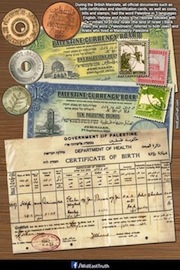Posted by david barrett

Subscribe to our
mailing list
|
 Thu Jul 16, 2009 2:05 pm Build a Museum of Arab Terror Thu Jul 16, 2009 2:05 pm Build a Museum of Arab Terror
|
 |
|
| |
On a recent visit to Europe, I stopped by the Lenin Museum in the Finnish city of Tampere, only to discover that it presented a laudatory and completely distorted view of the brutal dictator.
But it did get me thinking: Look how easy it is to distort history and to cast aside those who were terrorized, tortured and killed. Indeed, here we see this on a daily basis in how much of the mainstream media reports the conflict in the Middle East. History is being written, and the truth is being twisted, before our very eyes every day.
Hence, as I argue in the column below from the Jerusalem Post, we must take action to ensure that this does not occur, and that the Israeli victims of terrorism are never forgotten. And a good first step would be for the Government of Israel to erect a Museum of Arab Terror to document this scourge as well as to pay tribute to its victims.
Comments and feedback may be sent to: letters@jpost.com or to me directly.
thanks,
Michael Freund
http://www.jpost.com/servlet/S.....2FShowFull
The Jerusalem Post, July 16, 2009
By Michael Freund
In the Finnish city of Tampere stands one of the strangest exhibitions in all of Europe. Located inside the hall where Vladimir Lenin first met Joseph Stalin in 1905, the Lenin Museum traces his life and work as he rose to power and built a communist empire.
It dates back to the Cold War, when the Soviets sought to spread socialist propaganda in the West, and is now owned and operated by the Finland-Russia Society with support from the Finnish Ministry of Education.
And while the curators of the museum insist that it presents a "critical" approach to Lenin and his labors, that is far from being the truth.
Having studied Soviet politics in my university days, I visited the museum last month expecting to find a balanced account of the man and his deeds. After all, Lenin persecuted, imprisoned and murdered his political opponents - both perceived and real, set up concentration camps for his enemies, brutally liquidated vast swathes of the Russian peasantry and engineered massive famine in the countryside.
All this in addition to bequeathing to the world totalitarian Soviet rule and paving the way for Stalin and his ruthless regime.
But you would never know it from the material on display in Tampere. Instead, the museum's guide is full of laudatory honorifics, hailing Lenin for rallying the Russian masses "to defend the socialist fatherland."
"Under his leadership, the people resisted the enemies of the revolution ever more strongly," reads the written guide to display case 13.
Lenin may have died in January 1924, "but his ideas and deeds live on," the museum helpfully assures its visitors.
After engaging in a somewhat-heated argument with the museum's employees over the unbalanced picture they presented of their subject, I left a few scathing comments in the guest book and walked out shaking my head in disbelief.
Sure, one could dismiss this place as an anachronism, a holdover from the Cold War more worthy of ridicule than respect. But the fact is that museums matter. They are society's way of telling a story, of building a narrative about the past to educate future generations. There is no telling how many people might be affected by what they see within its halls.
And it just seems so absurd that instead of telling the story of Lenin's victims, this odd little museum would prefer to glorify their killer.
BUT IT did get me thinking: Look how easy it is to distort history and to cast aside those who were terrorized, tortured and killed. Indeed, here we see this on a daily basis in how much of the mainstream media reports the conflict in the Middle East. History is being written, and the truth is being twisted, before our very eyes every day.
What will happen 25 or 50 years from now, when people look back on the events of today? Will anyone remember the recent struggle of the people of Sderot and the rockets they endured, or the suicide bombings? I suspect that much of this is already being forgotten, if only because of the natural human tendency to try to bury the painful past.
But we must take steps to ensure this does not occur, and that the truth is not obscured by propaganda. The government therefore should build of a museum of Arab terror with the goal of documenting and commemorating the victims of Arab violence. Such a museum would not only serve to remind its visitors of the immense human suffering that terror has inflicted on Israel over the decades, but would also honor those who lost their lives to this scourge.
Though a monument to victims of terror was established on Mount Herzl, where an annual ceremony is now held on Remembrance Day, much more can and should be done to perpetuate their legacy - and a museum can do just that.
With effective displays and relevant historical information and photographs, such a museum can help to educate the public about the past and thereby better prepare them for the future. And it will help to counter those who try to falsify our history.
Like it or not, the only way to truly appreciate the difficulties this country has faced, and to comprehend its struggle for survival, is to study and understand the phenomenon of Arab violence and hatred.
Upon completion, the museum of Arab terror should become a mandatory part of every foreign dignitary's state visit, and it should be incorporated into the curriculum of every high school student in the country.
It might sound like a dismal or gloomy theme upon which to base an exhibition. But museums are akin to a nation's collective memory bank, and one never knows the impact they can have. The erection of a museum of Arab terror would be an important step toward ensuring that its victims, unlike those of Lenin and his ilk, will not be forgotten.

|
|
|
|











